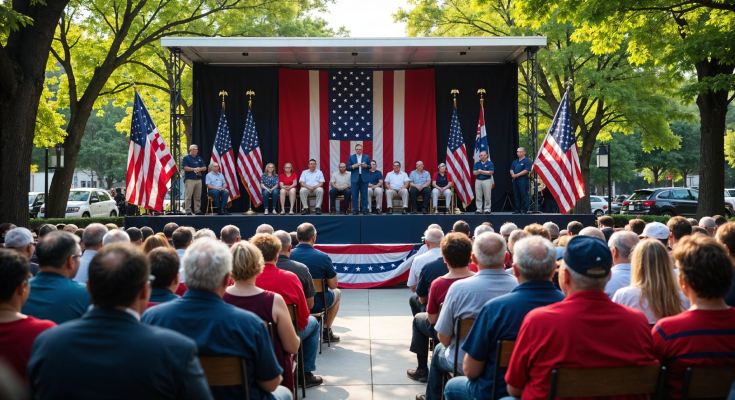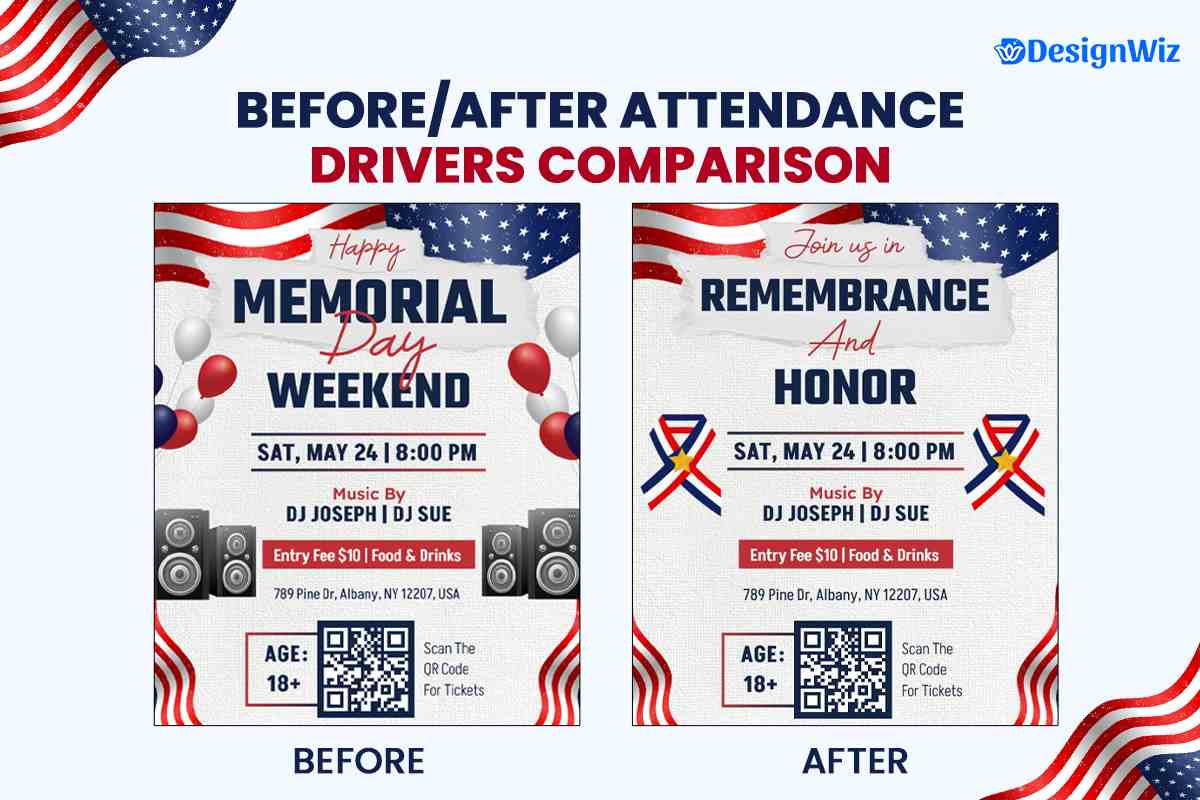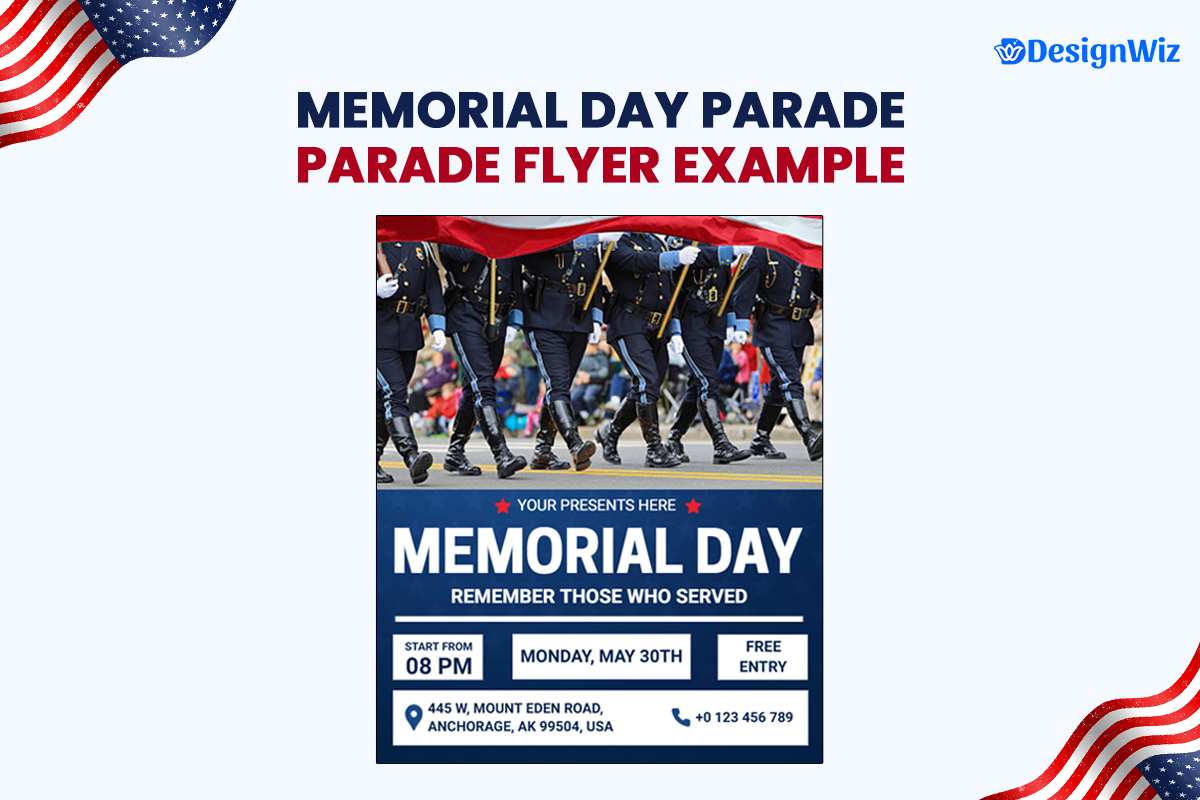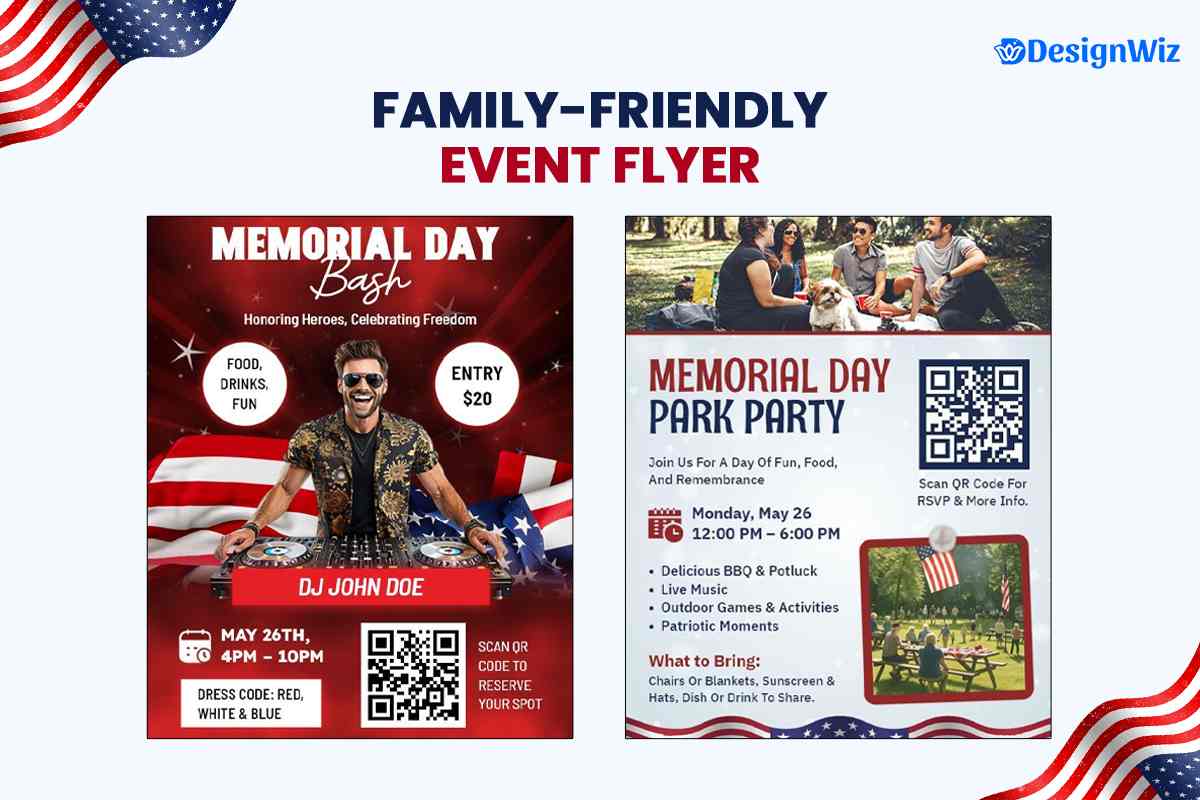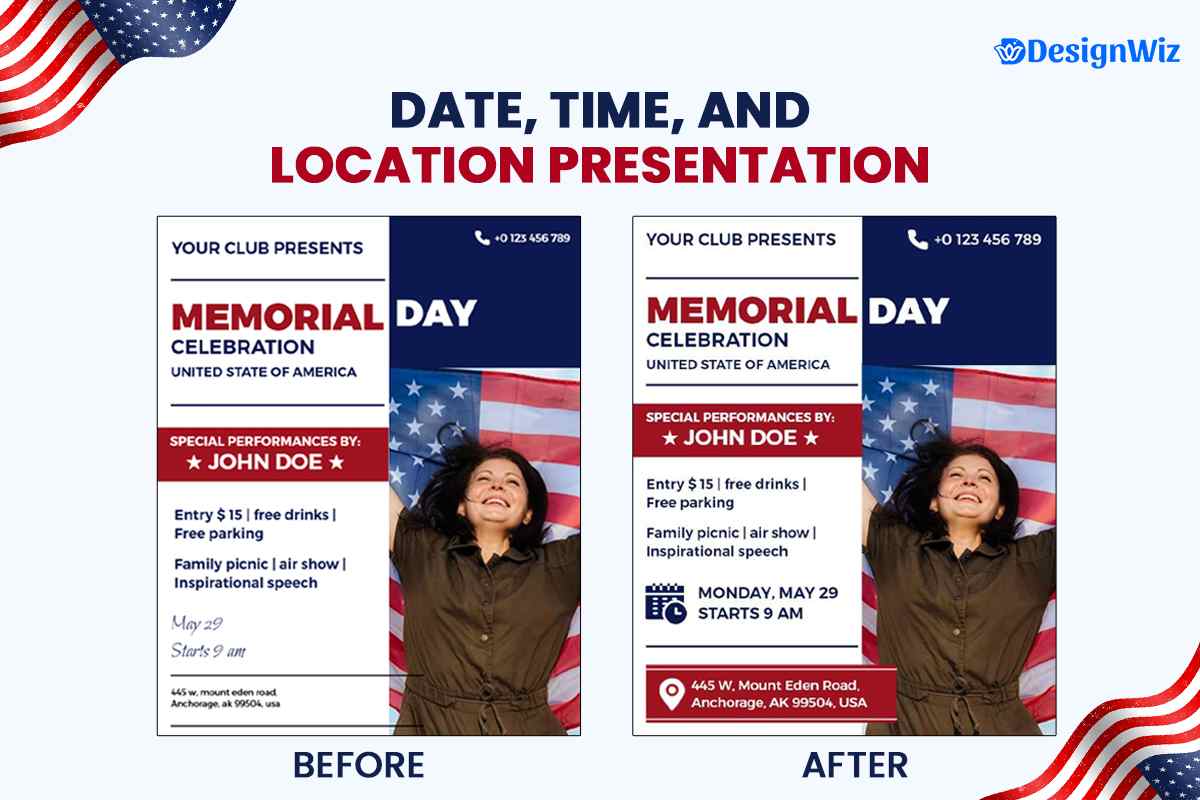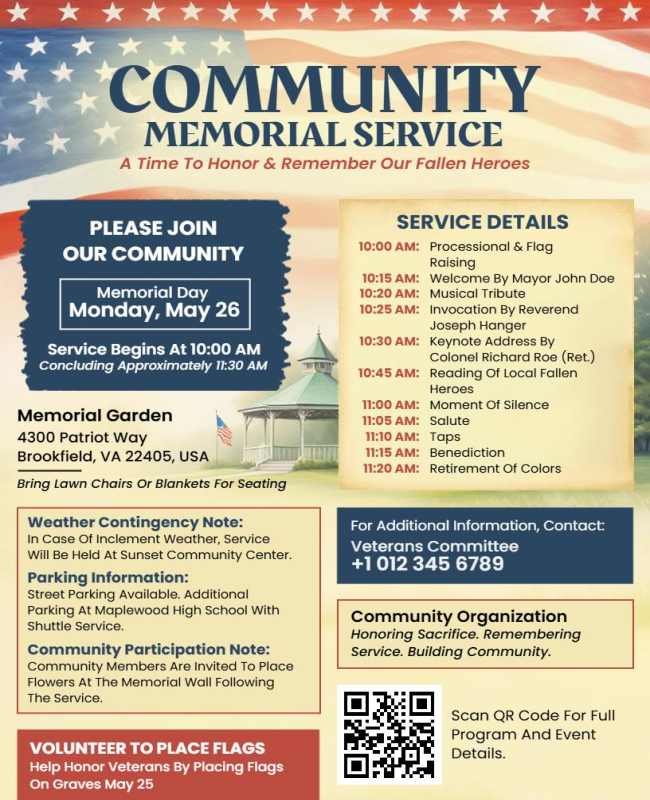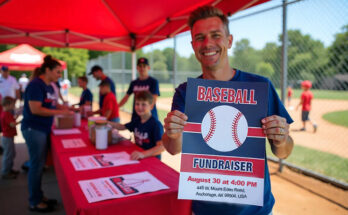Get ready made flyer templates that spark community excitement perfect for parades, local gatherings, and Memorial Day events.
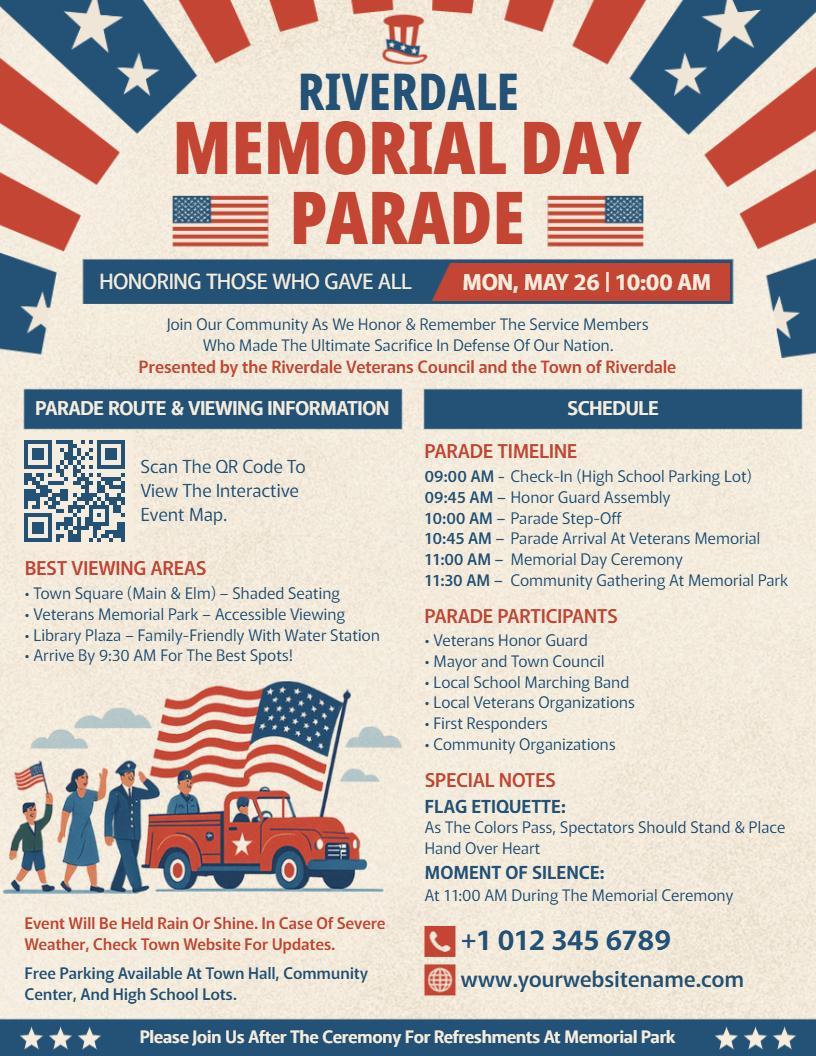
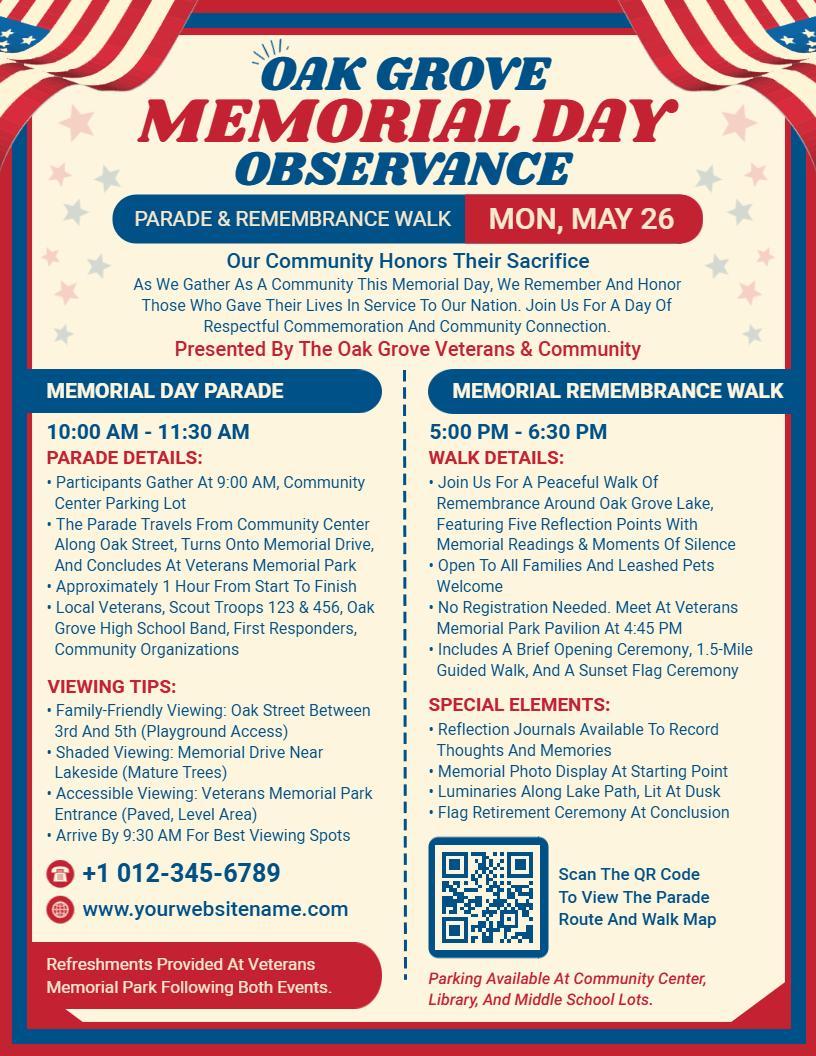


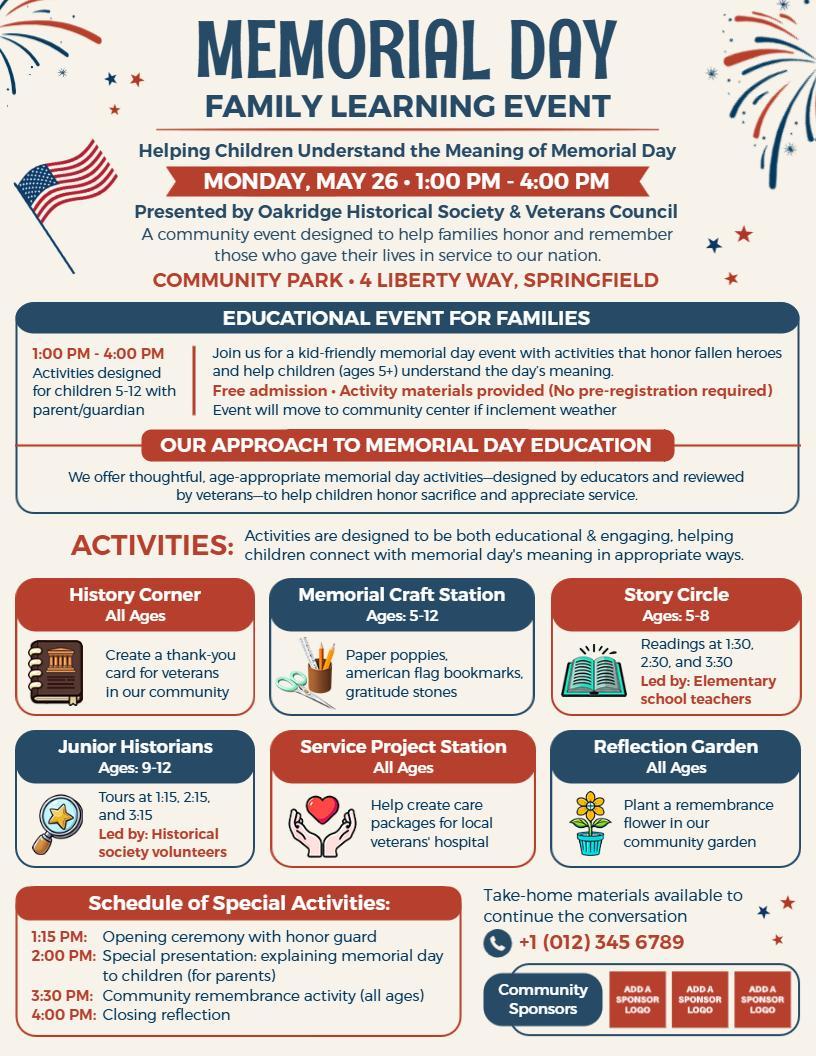


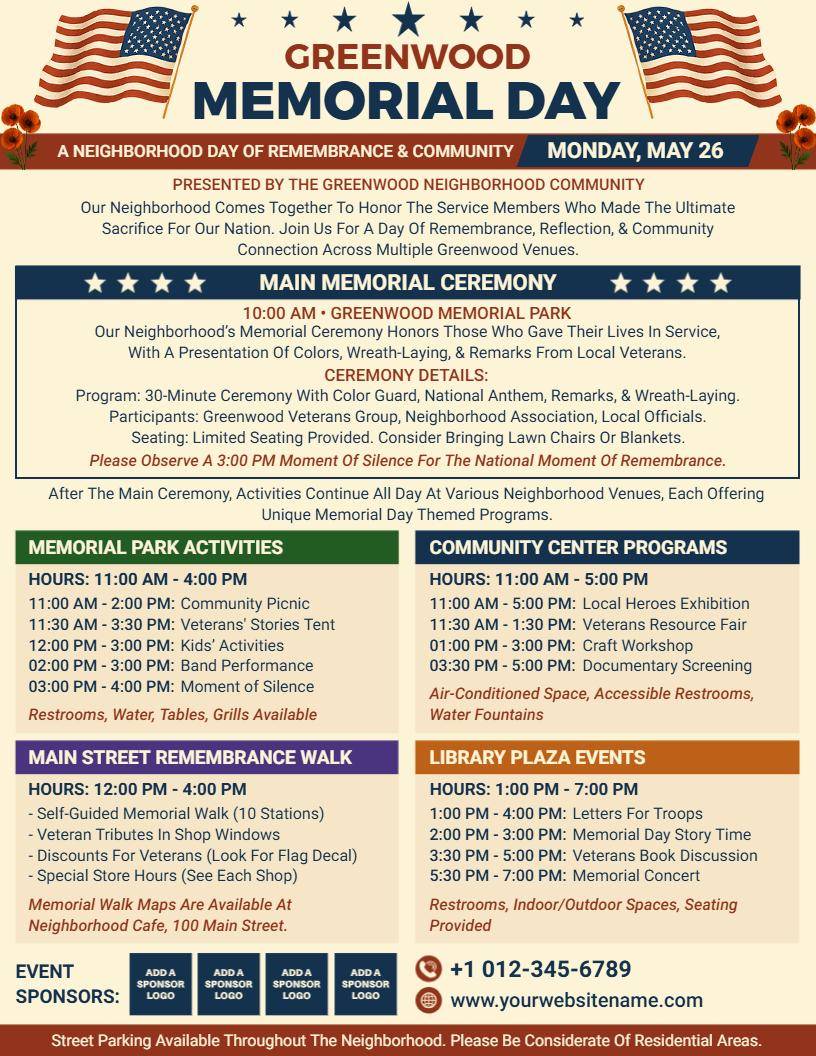
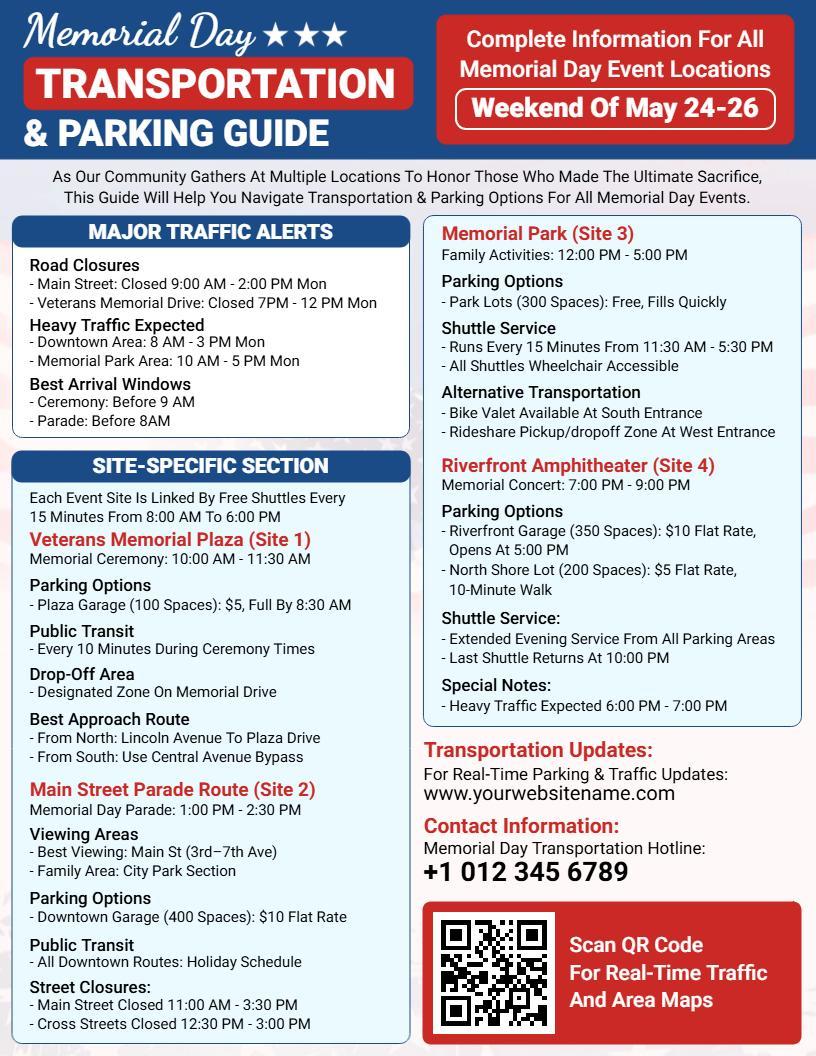
Designing Memorial Day flyers for community events presents unique challenges: balancing respect for the holiday’s solemn purpose while creating materials that effectively promote local gatherings, parades, and ceremonies that bring people together to honor fallen service members.
For general Memorial Day design principles, see our Memorial Day Flyer Design Guide. For detailed guidance on symbolism and imagery, refer to our Memorial Day Symbolism Guide.
What Design Elements Work Best For Memorial Day Parade Flyers?
Parade flyers require specialized elements to effectively communicate route information, participation details, and viewing opportunities while maintaining appropriate memorial context.
Route Map Integration
Effective parade route maps balance clarity with visual appeal effective parade route maps balance clarity with visual appeal.
Essential Map Elements
- Complete route with start/end points clearly marked
- Street names and major intersections
- Viewing area recommendations
- Assembly areas for participants
- Key landmarks for orientation
- Ceremony locations (if parade leads to ceremony)
Implementation Best Practices
- Use simplified maps focusing on essential elements
- Incorporate directional indicators (arrows, dotted lines)
- Include timing estimates for different sections of route
- Highlight special viewing areas or grandstands
- Note accessibility information along the route
Memorial Day Parade Route Planner
Planning or attending a memorial day parade requires understanding the route, viewing options, and logistical details. Use this interactive tool to create or visualize parade routes, identify optimal viewing locations, and share route information with your community.
Community Planning Tip: When creating your Memorial Day Parade Route, consider incorporating local landmarks with historical or military significance. Balance the route length with expected weather conditions and ensure you’ve planned for adequate shade, rest areas, and accessible viewing points. Share your route plan with local businesses along the path so they can prepare for increased foot traffic.
Design Approaches
- Integrate map with overall flyer design rather than using generic maps
- Consider stylized maps that highlight route while simplifying other elements
- Use color coding to distinguish the parade route from other information
- Include small reference maps showing route in context of larger area
- Consider including detail insets for complex sections
Parade Lineup Information
Clear participation information is essential for organized parades:
Participant Information To Include
- Assembly time and location (earlier than start time)
- Lineup position and order information
- Check-in procedures for participants
- Preparation requirements or restrictions
- Dispersal information after conclusion
Viewing Information
- Best viewing locations with amenities
- Timing estimates for when parade will reach different points
- Areas with shade, seating, or special accommodations
- Family-friendly viewing recommendations
- Ceremony viewing transitions if applicable
Formatting Recommendations
- Present lineup information in chronological order
- Consider using numbered positions for major units
- Provide separate details for participants vs. spectators
- Include contact information for parade coordination
- Highlight VIP or special honor units
Viewing Location Highlights
Help community members plan their parade viewing experience
Viewing Location Elements
- Prime viewing area identification
- Amenities available at different locations (seating, shade, restrooms)
- Accessibility information for those with mobility challenges
- Family-friendly viewing areas
- Special viewing sections (veterans, seniors, etc.)
Navigation Guidance
- Walking routes to viewing areas from parking
- Estimated crowd density in different areas
- Entry and exit points for viewing areas
- Restricted areas or street closures
- Guidance for moving between viewing and ceremony locations
Presentation Approach
- Use visual indicators on maps for different amenities
- Consider a table format comparing different viewing locations
- Highlight accessibility information prominently
- Include arrival time recommendations for preferred viewing
- Note special considerations (shade, sound systems, etc.)
What Makes An Effective Memorial Day Community Event Flyer?
An effective Memorial Day community event flyer balances patriotic elements with practical event information while maintaining appropriate respect for the holiday’s significance. Unlike purely commercial promotions or strictly military observances, community events must navigate dual purposes: honoring fallen service members while fostering community togetherness. A customizable flyer templates makes it easier to strike this balance by allowing flexibility in design and messaging.
Balancing Community Celebration With Respectful Commemoration
Community events have distinct considerations that differ from both military ceremonies and commercial promotions:
- Dual Audience: Community events serve both military-connected residents who understand the holiday’s significance and general community members who may be less familiar with military traditions.
- Multiple Purposes: Many community events combine solemn remembrance ceremonies with more celebratory community gatherings like parades, picnics, or family activities.
- Educational Role: Community flyers often have an educational component, helping residents understand the holiday’s significance while promoting participation.
- Inclusive Approach: Community events typically aim to welcome all residents regardless of military connection, requiring inclusive design and messaging.
Creating an effective balance means visually and verbally distinguishing between solemn remembrance elements and community gathering aspects, while ensuring the former maintains priority in presentation.
Learn more about Memorial Day flyers for military and veterans organizations to understand how design and messaging can respectfully honor service while informing and engaging the broader community.
Key Elements That Drive Attendance
Community Memorial Day flyers must motivate attendance while maintaining appropriate respect:
Essential Attendance Drivers
- Clear Value Proposition: Why should community members participate? (historical significance, community tradition, honoring service members)
- Accessibility Information: Transportation options, parking availability, accessibility for disabled attendees
- Family-Friendly Elements: Age-appropriate activities, and facilities available for families with children
- Weather Considerations: Contingency plans for inclement weather, recommended preparations for outdoor events
- Community Participation: Opportunities for active involvement rather than passive observation
Appropriate Motivational Elements
- Emphasis on communal remembrance and shared values
- Historical significance to the specific community
- Recognition of local veterans and service members
- Community tradition and annual significance
Elements to Avoid
- Entertainment-focused messaging that overshadows remembrance
- Overly festive language or imagery
- Marketing tactics that create false urgency or fear of missing out
Information Hierarchy For Community Events
Community event flyers require precise information hierarchy to communicate complex event details while maintaining memorial significance:
- Memorial Purpose: Clear acknowledgment of Memorial Day’s significance (remember fallen service members)
- Event Overview: Basic what/when/where in prominent position
- Schedule Breakdown: Timeline of activities with clear distinctions between ceremonial and community elements
- Participation Information: How community members can actively participate or observe
- Logistical Details: Parking, transportation, weather contingencies
- Community Context: Local significance, history, and connections
This hierarchy ensures the memorial purpose maintains priority while providing necessary practical information.
Since the first memorial day ceremony at puowaina in 1949, the City and County of Honolulu has worked with numerous veteran, community, and educational organizations to facilitate this time-honored tradition, emphasizing the historical and communal significance of the observance.1
Visual Appeal For Public Audiences
Community flyers must appeal to a broader audience while maintaining appropriate dignity:
Design Balance Recommendations
- Use patriotic elements thoughtfully rather than as decorative features
- Incorporate local landmarks or community symbols alongside traditional memorial imagery
- Choose typography that balances readability with appropriate dignity
- Create clear visual distinction between ceremonial and community gathering information
- Use photography that captures community connection to memorial traditions
Community-Appropriate Visual Elements
- Local war memorials or monuments
- Images of past community ceremonies (showing respectful participation)
- Local landscape elements with subtle patriotic additions
- Historic photographs connecting the community to military service
- Simple maps or route indications for parades/processions
Visual Elements To Avoid
- Generic celebration imagery (balloons, fireworks, etc.)
- Overly commercial or promotional visuals
- Cluttered designs that diminish the memorial significance
- Stock photography that lacks authentic community connection
How Should You Design Flyers For Different Types of Memorial Day Community Events?
Different community events require tailored approaches that reflect the specific nature of the gathering while maintaining appropriate respect for Memorial Day’s purpose.
Parades and Processions
Memorial Day parades require specific design elements that balance community celebration with respectful remembrance:
Key Design Considerations
- Route maps with clear start/end points and viewing areas
- Timeline information (assembly, step-off, and estimated completion times)
- Participant information (local veterans groups, bands, community organizations)
- Viewing recommendations (best locations, accessibility information)
- Clear distinction between the parade and any ceremonies that follow
Content Requirements
- Explicit connection to Memorial Day’s purpose of honoring fallen service members
- Information about any ceremonial elements within the parade (moments of silence, wreath presentations)
- Community participation guidelines (appropriate ways to show support)
- Historical context for the community’s parade tradition
- Patriotic elements balanced with local community identity
Visual Approach:
- Dynamic layout suggesting movement and procession
- Maps or route graphics with clear landmarks
- Balance of patriotic elements with community identity
- Historical and contemporary parade imagery showing respectful participation
- Clear information hierarchy distinguishing ceremonial and community elements
According to marketing research memorial day parades and ceremonies remain a core tradition, with local veterans’ organizations and community groups hosting events that connect families and honor the nation’s military sacrifice.2
Community Ceremonies
Community ceremonies focus more directly on remembrance and require a more solemn design approach:
Key Design Considerations
- Formal, dignified layout with clear information hierarchy
- Prominent recognition of the ceremony’s memorial purpose
- Program information with speaker identification and ceremony elements
- Specific protocol information for community participants
- Historical context for the local ceremony tradition
Content Requirements
- Detailed schedule of ceremonial elements
- Information about participating veterans organizations or military units
- Guidelines for appropriate community participation
- Historical significance of the ceremony location
- Connection to national Memorial Day observance
- Clear information about ceremony traditions (playing of Taps, wreath placements)
Visual Approach
- More formal design with traditional memorial elements
- Imagery of local memorial sites or monuments
- Dignified typography and layout
- Patriotic elements used in traditional, respectful ways
- Photography from past ceremonies showing proper observance
Family-Friendly Events
Many communities host family-friendly events that include educational and age appropriate activities:
Key Design Considerations
- Clear visual distinction between ceremonial elements and family activities
- Age-appropriate explanation of Memorial Day’s significance
- Information about educational opportunities within the event
- Family logistics (facilities, food availability, schedule)
- Balance between accessibility for children and respect for the holiday
Content Requirements
- Educational content about Memorial Day’s meaning
- Schedule clearly separating solemn elements from family activities
- Guidelines for teaching children about appropriate respect
- Information about family friendly facilities and accommodations
- Community-building elements that connect to the holiday’s significance
Visual Approach
- Welcoming design that remains respectful
- Imagery showing families participating in meaningful ways
- Educational elements that explain traditions to children
- Clear schedule formatting distinguishing different event elements
- Balance of accessibility and appropriateness
Combined events
Many communities host events that combine multiple elements, requiring careful design to maintain appropriate distinctions:
Key Design Considerations
- Clear visual separation between ceremonial and community elements
- Chronological presentation of activities with appropriate transitions
- Consistent acknowledgment of memorial purpose throughout
- Unified design that maintains distinct sections for different activities
- Guidance for appropriate participation in different event components
Content Requirements
- Comprehensive schedule with clear activity categorization
- Transitional information between solemn observances and community activities
- Consistent memorial messaging throughout all event elements
- Appropriate behavior guidelines for different activities
- Unified theme that connects all elements to Memorial Day’s purpose
Visual Approach
- Sectioned design with clear visual transitions
- Color coding or design elements that distinguish activity types
- Timeline presentation showing appropriate flow of events
- Imagery reflecting both solemn and community aspects
- Consistent memorial elements maintained throughout
What Essential Information Must Be Included on a Memorial Day Community Event Flyer?
Community Memorial Day events have unique information requirements that different from both standard community events and purely military observances.
Date, time, and location details
Precision in basic event information is essential:
Date Information
- Day of week and date with year specified
- Clear start and end times for the overall event
- Specific timing for ceremonial elements (often early morning)
- Duration expectations for different activities
- Setup and arrival time recommendations if relevant
Location Specifications
- Complete address with specific gathering points identified
- Landmarks or reference points for large venues
- Distinct locations for different event elements if applicable
- GPS coordinates for remote or large outdoor venues
- Meeting point information for parades or processions
Presentation Best Practices
- Present date and time information prominently
- Clearly distinguish between different event elements if times vary
- Consider using timeline formatting for complex schedules
- Include military time (0900) alongside standard time (9:00 AM) for ceremonial elements
- Provide specific guidance for early arrival if appropriate for ceremonies
Event Schedule Breakdown
For multi-part community events, schedule details require careful organization:
Schedule Elements to Include
- Chronological listing of all activities with specific times
- Clear designation of ceremonial vs. community activities
- Duration estimates for each element
- Transition information between activities
- Weather contingency schedules if applicable
Formatting Recommendations
- Use visual hierarchy to distinguish between ceremonial and community elements
- Consider color coding or icons to categorize different activities
- Present in easy to scan format (timeline, table, etc.)
- Include notes about appropriate arrival times for specific elements
- Highlight ceremonial elements requiring specific etiquette
Essential Ceremony Elements to Specify
- National Anthem performance
- Presentation of Colors
- Wreath-laying ceremony
- Moment of silence timing
- Keynote speeches
- Reading of names
- Playing of Taps
- Flag ceremonies (raising to full staff, etc.)
Parking and Transportation Information
Logistical details significantly impact attendance at community events:
Parking Information
- Available parking locations with capacity estimates
- Restricted or reserved parking areas
- Handicapped parking locations and availability
- Distance from parking to event locations
- Cost information if applicable
Transportation Options
- Public transportation availability and schedules
- Shuttle services if provided
- Bicycle accommodations
- Ride-sharing pickup/drop-off locations
- Walking routes from transportation hubs
Street Closure Information
- Roads closed for parades or ceremonies
- Closure timing and reopening estimates
- Detour recommendations
- Impact on access to event locations
Presentation Approach
- Include simple maps highlighting parking areas
- Use icons or symbols for different transportation options
- Provide this information prominently for large events
- Consider QR codes linking to detailed transportation information
- Include contact information for transportation questions
Weather Contingency Plans
Outdoor Memorial Day events require clear weather contingency information:
Elements To Include
- Alternative locations for indoor backup if available
- Cancellation criteria and notification procedures
- Rain date information if applicable
- Modified schedule for weather-impacted events
- Guidance on appropriate preparation (seating, umbrellas, etc.)
Presentation Recommendations
- Present contingency information clearly but not prominently
- Use icons or symbols to indicate weather-related information
- Include communication channels for day-of-event updates
- Provide website or social media information for status updates
- Consider weather-specific QR codes linking to updated information
Contact Information and Sponsors
Proper recognition and contact information are essential:
Contact Elements
- Organizing committee or primary contact
- Day of event contact for questions
- Email and phone information
- Website and social media channels
- Clear identification of the organizing entities
Sponsor Recognition
- Appropriate acknowledgment of event sponsors
- Clear distinction between sponsors and memorial elements
- Tasteful logo placement that doesn’t overshadow purpose
- Veteran organization recognition
- Municipal or government entity identification
Presentation Guidance
- Keep contact information accessible but not prominent
- Ensure sponsor recognition is tasteful and appropriately sized
- Position sponsor information separately from ceremonial elements
- Recognize military and veteran organizations prominently
- Include community service information when appropriate
Case study: Small Town Memorial Day Parade and Ceremony
Example: Riverdale Memorial Day Parade and Remembrance Ceremony
Key Design Elements
- Two section layout clearly distinguishing parade from ceremony
- Route map with viewing recommendations and accessibility information
- Timeline showing progression from parade to ceremony
- Historic town landmark imagery with subtle patriotic elements
- Heritage photographs connecting current event to community tradition
Content Strengths
- Clear schedule separating parade elements from ceremonial observance
- Educational sidebar explaining Memorial Day significance
- Detailed parking information with handicapped accessibility notes
- Weather contingency plans clearly presented
- Appropriate participation guidance for different age groups
Effective Elements
- Local veteran organization recognition
- Historical context connecting community to military service
- Volunteer opportunities clearly presented
- Family participation suggestions
- QR code linking to expanded online information
What Makes It Successful
- Balances community celebration with respectful commemoration
- Provides comprehensive information in well-organized format
- Connects local community identity with national observance
- Creates clear distinction between different event elements
- Maintains appropriate tone while being accessible to all community members
What Are Effective Distribution Strategies For Community Memorial Day Flyers?
Community events require strategic distribution to reach diverse audiences while respecting the holiday’s significance.
Local Business Partnerships
Local businesses can serve as effective distribution points:
Partnership Approaches
- Counter or window displays in high-traffic businesses
- Inclusion in shopping bags or receipts
- Digital display on business screens or kiosks
- Co-branding opportunities with community-minded businesses
- QR codes in business locations linking to complete information
Strategic Business Selection
- Businesses with community-focused missions
- Locations frequented by diverse community segments
- Veteran-owned or military-friendly businesses
- High-visibility storefronts in community centers
- Businesses with historical community connections
Implementation Best Practices
- Provide display materials rather than just flyers
- Recognize business partners appropriately in materials
- Create business-specific versions if appropriate
- Track which locations generate most participation
- Express appreciation to business partners after the event
Community Bulletin Boards
Strategic use of community posting locations:
Effective Posting Locations
- Municipal buildings and community centers
- Libraries and educational institutions
- Places of worship (with permission)
- Community organization facilities
- Parks and recreation facilities
- Senior centers and retirement communities
Posting Strategies
- Create different sizes for different bulletin boards
- Use attention grabbing headers while maintaining dignity
- Include tear off elements with essential information
- Regularly check and refresh postings
- Follow posting guidelines for each location
Design Considerations
- Ensure readability from typical viewing distance
- Use larger formats for outdoor bulletin boards
- Create weather resistant versions for outdoor posting
- Consider simplified versions for smaller spaces
- Include QR codes linking to complete information
Digital Community Groups
Leverage online community spaces for distribution:
Digital Channels
- Community Facebook groups and pages
- Neighborhood apps (Nextdoor, etc.)
- Community calendars and event listings
- Local news site community boards
- Municipal and library websites
- School and educational institution networks
Digital Distribution Best Practices
- Create platform-specific formats optimized for each channel
- Develop shareable content that community members can redistribute
- Include all essential information in both text and graphic formats
- Respond promptly to questions on digital platforms
- Create event pages that can be updated with current information
Content Adaptations
- Simplified graphics for mobile viewing
- Text-based versions for accessibility
- Interactive elements for digital engagement
- Countdown elements for digital platforms
- Shareable individual elements (route maps, schedules)
Local Media Opportunities
Engage traditional local media channels:
Media Channels
- Local newspapers (print and online)
- Community radio stations
- Local television community calendars
- Regional magazines and publications
- Community newsletters
Approach Strategies
- Provide press releases with complete event information
- Develop human interest angles connecting community members to the event
- Offer historical background about the community’s Memorial Day traditions
- Provide high quality images from previous events
- Connect reporters with key organizers for interviews
Content Preparation
- Create media kit with comprehensive information
- Develop quotes from organizers and participants
- Prepare historical context and significance information
- Identify compelling visual opportunities for coverage
- Highlight unique or special elements of this year’s event
Timeline Recommendations
Strategic timing maximizes community awareness and participation:
Initial Announcement (6-8 Weeks Prior)
- Basic save-the-date information
- Historical photos from previous years
- Early planning committee recognition
- Calls for participation or volunteers
- Historical significance highlights
Detailed Information (3-4 Weeks Prior)
- Complete schedule and location details
- Participant information and registration deadlines
- Comprehensive maps and logistics
- Speaker and special guest announcements
- Specific volunteer needs and opportunities
Final Reminders (1-2 Weeks Prior)
- Schedule and location reinforcement
- Weather contingency reminders
- Parking and transportation emphasis
- Last-minute participation opportunities
- Updated special announcements or additions
Community Engagement Timing
- Build momentum with increasing frequency of reminders
- Create natural information flow from general to specific
- Balance advance planning needs with avoiding information fatigue
- Consider separate timing streams for participants vs. attendees
- Align with community planning rhythms (around other events)
Ready to create community event flyers that drive memorial day? For ready to use designs that incorporate these community-specific principles, explore our Memorial Day Community Event templates.
Memorial Day Community Event Flyer Collection
Discover a curated collection of Memorial Day flyer designs made for community events. From parades to local gatherings, find creative inspiration to design impactful promotional materials.
Community Parade Flyers
- Small Town Memorial Day Parade Flyer
- Metropolitan Memorial Day Parade Flyer
- Suburban Memorial Day Parade & Walk Flyer
Community Ceremony Flyers
- Traditional Town Memorial Ceremony Flyer
- Community Remembrance Service Flyer
- Historic Memorial Site Ceremony Flyer
Family-Friendly Event Flyers
- Memorial Day Family Learning Event Flyer
- Community Observance & Family Gathering Flyer
- Museum Family Program Memorial Day Flyer
Special Hours & Operations Flyers
- Small Town Full Day Memorial Day Flyer
- City Weekend Memorial Day Events Flyer
- Neighborhood Multi-Venue Memorial Day Flyer
Logistics & Information Flyers
- Memorial Day Ceremony Logistics Flyer
- Memorial Day Family Event Planning Flyer
- Memorial Day Transportation & Parking Guide Flyer
Frequently Asked Questions
Begin distribution 4-6 weeks before the event, with initial announcements for save-the-date purposes.Follow with detailed information 3-4 weeks prior, and final reminders 1-2 weeks before the event.
Standard letter size (8.5″ × 11″) works for most indoor bulletin boards, while 11″ × 17″ tabloid size is more effective for outdoor community boards where visibility from a distance is important.
Use clear visual distinction between events (color coding, borders, or sections), present information chronologically, provide a master schedule and individual event details, and use consistent formatting for each event while maintaining clear connections to Memorial Day’s purpose.
Yes, if applicable. Clearly state whether events are free or require payment, detail any suggested donations, explain how proceeds will be used (especially if benefiting veteran causes), and provide information about discounts for military families or veterans.
Focus on local connection (highlight community-specific memorial traditions), use authentic photography from previous years’ events, incorporate unique local landmarks, feature community members actually participating, and create a distinctive but appropriate design that respects the holiday’s purpose.
People Also Ask
1. How should we acknowledge veterans in our community Memorial Day flyer?
Distinguish between Memorial Day (honoring those who died in service) and Veterans Day (honoring all who served), include a specific section recognizing veterans’ participation in the event, highlight veteran organizations involved in planning, and provide information about how the community can support veterans’ causes.
2. What information is most important for first-time attendees?
For first-time attendees, prioritize clear location details with landmarks, parking and transportation guidance, schedule information with recommended arrival times, explanation of event traditions and appropriate participation, and educational context about Memorial Day’s significance.
3. How can we balance patriotic elements with local community identity?
Incorporate local landmarks alongside patriotic symbols, feature community-specific memorial sites or monuments, highlight local military history connections, use community color schemes complemented by patriotic elements, and include photographs showing community members engaged in memorial traditions.
Conclusion
Creating effective Memorial Day flyers for community events requires thoughtful balance between honoring fallen service members and fostering community participation. By following these guidelines, you can develop materials that maintain appropriate respect while effectively promoting inclusive local gatherings.
Key Takeaways
- Clearly distinguish between ceremonial elements and community activities
- Provide comprehensive logistical information without diminishing memorial purpose
- Create inclusive materials that welcome diverse community members
- Distribute through multiple channels to reach your entire community
- Maintain appropriate dignity while creating accessible, engaging content
References:
1. Memorial Day parade announcement. Village of Mamaroneck, NY. Retrieved May 6, 2025, from Village of Mamaroneck.
2. Mayor’s Memorial Day. City and County of Honolulu ,Retrieved May 6, 2025, from Department of Parks and Recreation. (n.d.).
